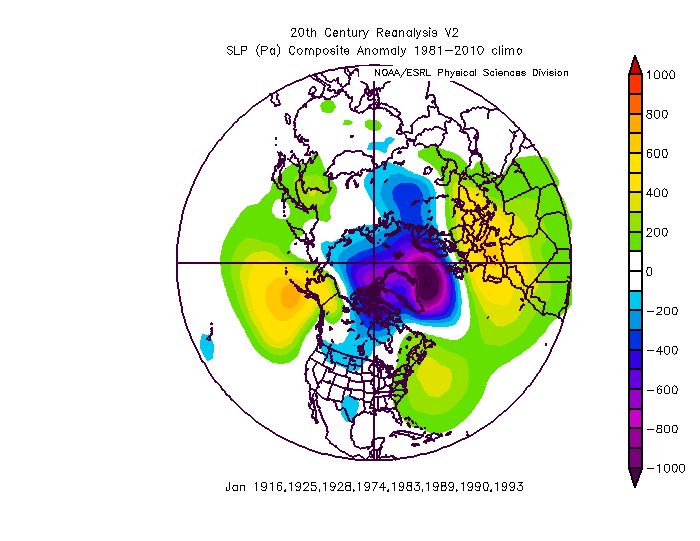20CR Climate Indices: North Atlantic Oscillation (NAO)
- Description:
- This mode describes variability over the northern Atlantic ocean, eastern North America and western Europe. The NAO represents the relative strength of the Icelandic low and the Azores high. It is typically defined as the pressure difference between Lisbon, Portugal and Reykjavík, Iceland though there are other definitions. A positive index is associated with a stronger westerlies and warmer winters/cooler summers in Europe and warmer winter temperatures in Eastern North America. A negative index is associated with decreased westerlies over the Atlantic. Further, European areas tend to have cold dry winters and storms track southwards toward the Mediterranean Sea, with increased storm activity and rainfall in southern Europe and North Africa.
- Images:
- Calculation Method:
- We used a station based definition (rather than an EOF based one) similar to that of Hurrell (see other links below). We took as our pressure datasets, gridded 20th Century Reanalysis V2 sea level pressure (SLP) values. Two timeseries starting in 1836 (1851 for 20CRV2c) for the closest 20CR grids to Lisbon, Portugal [37.71,9.14W uses 38N,10W] and Reykjavík, Iceland [64.13N,21.93W uses 64N, 22W] were extracted. For each month of the year, we calculated a climatology based on 1836-2015 for each of the locations. The monthly climatology was then subtracted from each corresponding month of the whole timeseries to form anomalies. The standard deviation of each set of monthly anomalies was calculated using the years 1836-2015. Each monthly anomaly was divided by its corresponding standard deviation to form standardized data for Lisbon and for Reykjavik.
- Time Interval: Monthly
- Time Coverage: 1851 to 2011 (20CRV2c)
- Time Coverage: 1836 to 2015 (20CRV3)
- Update Status: none
- Get Data:
- Time Coverage: 1836 to 2015 (20CRV3)
-
NAO index from 20CRV2c: Standard PSL Format (What is standard format?)
NAO index from 20CRV3: Standard PSL Format (What is standard format?)
NAO index from 20CRV2c: Standard PSL Format (1948 onwards version)(What is standard format?)
NAO index from 20CRV3: Standard PSL Format (1948 onwards version)(What is standard format?)
- Source:
- The calculation method was applied at NOAA/PSL using 20CR V3 and 20CR V2c monthly means, respectively.
- References:
-
- Compo, G.P., J.S. Whitaker, P.D. Sardeshmukh, N. Matsui, R.J. Allan, X. Yin, B.E. Gleason, R.S. Vose, G. Rutledge, P. Bessemoulin, S. Brönnimann, M. Brunet, R.I. Crouthamel, A.N. Grant, P.Y. Groisman, P.D. Jones, M. Kruk, A.C. Kruger, G.J. Marshall, M. Maugeri, H.Y. Mok, Ø. Nordli, T.F. Ross, R.M. Trigo, X.L. Wang, S.D. Woodruff, and S.J. Worley, 2011: The Twentieth Century Reanalysis Project. Quarterly J. Roy. Meteorol. Soc., 137, 1-28. DOI: 10.1002/qj.776 (Free and Open Access.)
- Other Links
-
- Climatic Research Unit (CRU) NAO Data page.
- NOAA/NCEP Climate Prediction Center (CPC) NAO monitoring page including links to a monthly and daily NAO timeseries. Note that they use a EOF-based definition.
- NCAR Hurrell North Atlantic Oscillation (NAO) index (station-based).
- Wikipedia NAO article.
- Daily NAO Index forecast webpage based on the GEF2 Reforecast2 dataset.
  |
| Positive and negative NAO spatial patterns based on compositing Januaries with large negative and positive values of the NAO index. |